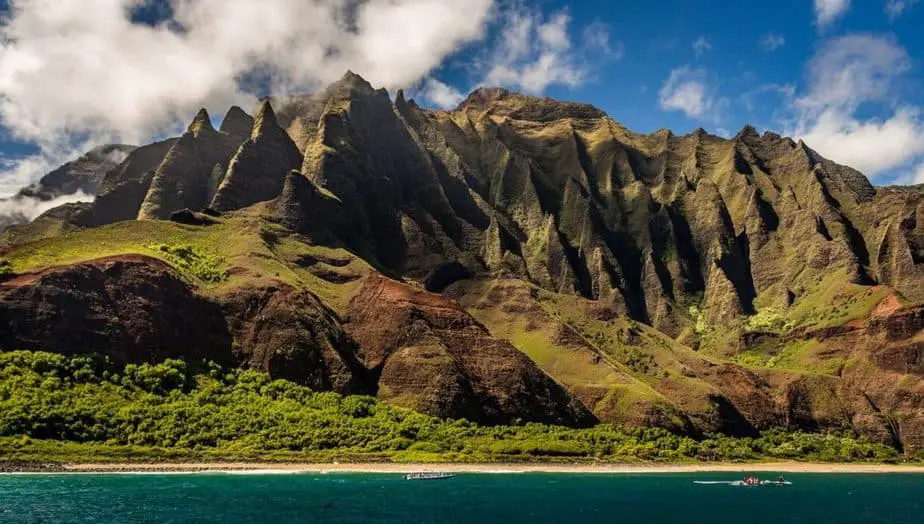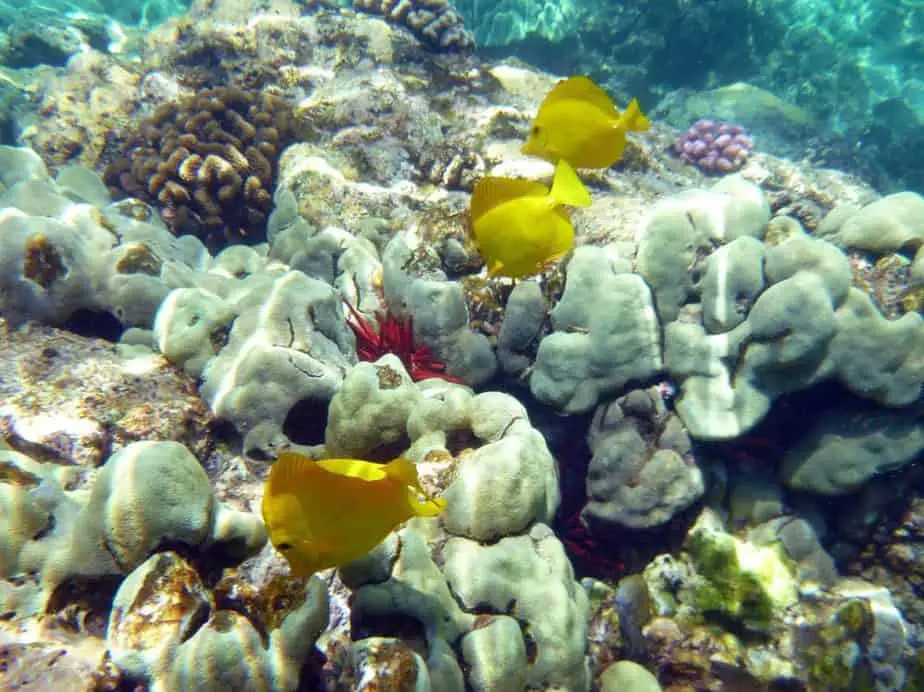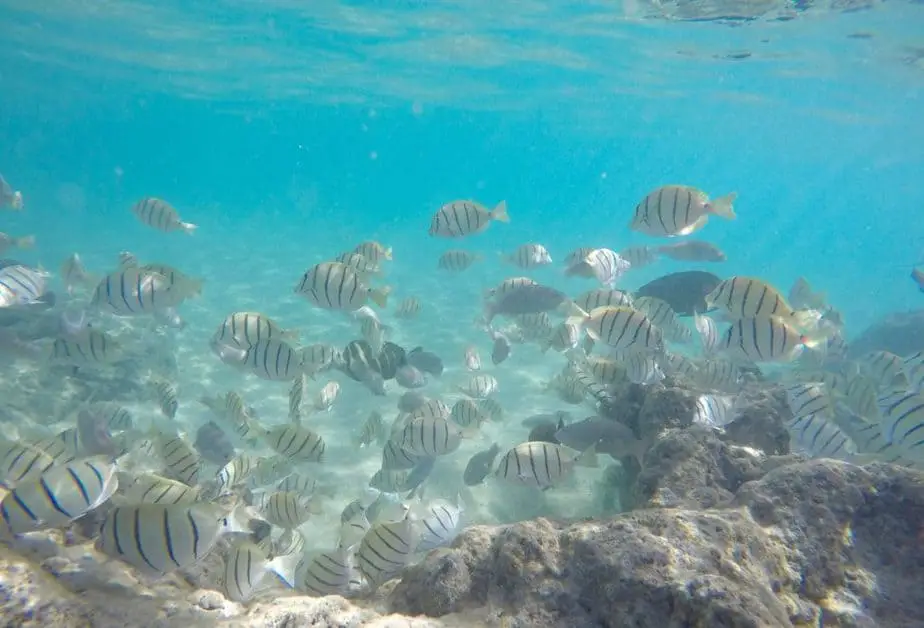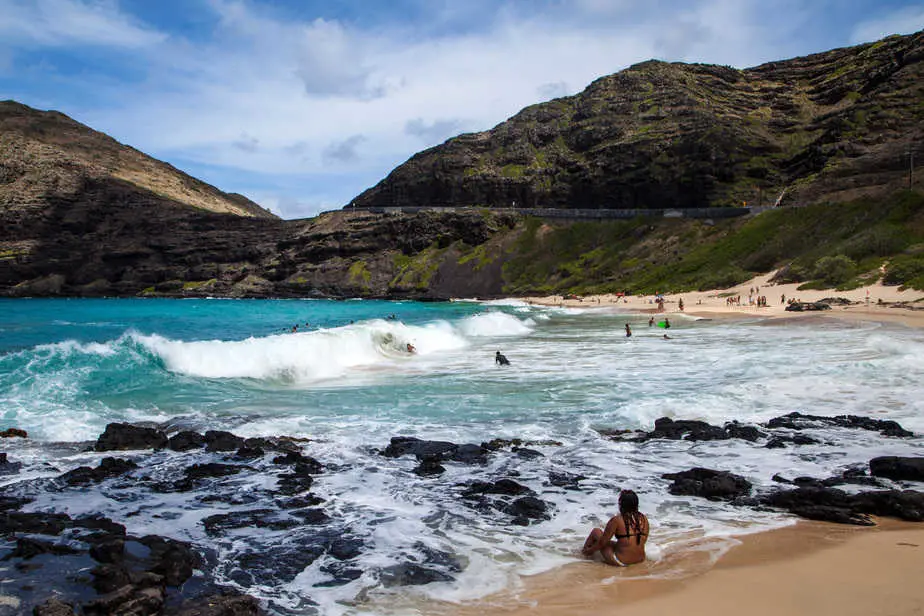When you hear people talking about the amazing time they had snorkeling in Hawaii, Mexico, Belize, or any other tropical snorkeling destination, they always leave out the important details about potential dangers to avoid and how to stay safe. While many like to think that these popular holiday destinations are the equivalent of utopia on Earth, and that all they need to worry about is what to bring, the reality is there are dangers people need to keep in mind to protect their family and themselves.
While snorkeling is a relatively safe hobby and so are the popular snorkeling spots that tourists love to visit, in this article we will go over some basic tips to help you and your family enjoy your snorkeling trip to Hawaii while staying completely safe.
Dangers of Snorkeling in Hawaii and How to Stay Safe
Never Snorkel Alone
In case you are new to snorkeling, we are going to start off with some general but important snorkeling tips before moving on to more Hawaii-specific snorkeling advice. Keep in mind, these tips are related to each other, so don’t skip ahead!
The first thing on our list is this time-tested piece of advice: never snorkel alone. It doesn’t matter how calm and idyllic the conditions may seem like in Hawaii, always have someone watching your back.
Always Keep Track of the Tide
Similarly, don’t float around carelessly and never turn your back to the ocean. It doesn’t matter how calm the waters were when you first went in. If you’ve spent any time around water, you know that the waves can pick up suddenly, and that ‘freak waves’ are actually surprisingly common.
Make it a habit when snorkeling to look up every few minutes to get your bearings. If you notice you’re drifting far away from shore or from your snorkeling buddy, then swim back before things have a chance to get worse. Even in beautiful Hawaii, this tip should not be forgotten.
Snorkel in the Morning
Yes, I know it’s a pain to wake up early when you’re on vacation. You just want to sleep in and relax, don’t you? But whether you’re in Hawaii or anywhere else, we recommend you snorkel in the morning. There are a few important reasons for this.
- The water will be calmer. The ocean conditions tend to pick up as the day progresses, so for the most relaxing and safe snorkeling experience, go early.
- The sun won’t be as damaging. Did you know that between 10AM to 4PM the sun produces 60% of its total UV radiation for the day? If you go before 10AM, you will avoid the brunt of the sun’s rays and protect your skin from its effects.
- Fish are plentiful and more active in the morning. If you want to see more fishies, don’t be lazy and get up early! This is also a great opportunity to take great underwater pictures and document the amazing times you had to share with family and friends.
Beware of Windy Days
Here’s some snorkeling arithmetic: wind + sandy bottom + water = strong waves and poor visibility. Wait, that was two answers. Oh well, math was never my strong suit but I can tell you from experience this is true. Anyways, when wind travels across the ocean’s surface it generates current.
Furthermore, if the wind is powerful enough, and the water is shallow, then the ocean floor will get stirred up. What that means is that sand and other particles will get kicked up, reducing the visibility underwater and making it unsafe and difficult to sea the fishes. Having strong currents doesn’t help in terms of safety.
When it comes to windy days, it is best not to go snorkeling if you want to stay safe. You want to have calm and visible waters, so the less wind the better. To help this snorkeling math equation work in your favor, go in the mornings and snorkel over the reefs.
Wear Sunscreen and UPF Clothing
Hawaii is a tropical destination close to the equator, which means it is exposed to the sun for almost the entire year. If you are not typically exposed to so much sun, you may not have sufficient snorkeling sun protection to protect your skin from its harmful UV radiation.
It doesn’t matter if you go out on a cloudy day, the sun’s UV rays can still penetrate the cloud cover. Don’t make the mistake of going out without any sunscreen or UPF protective clothing only to come back looking bright red. You wouldn’t want to spend the rest of your vacation having to painstakingly put on your aloha shirt because of your tender, sunburnt skin do you?
Hey, maybe if you have good image editing skills, you can get rid of the cooked lobster look. Or you can take your skin health very seriously and wear sunscreen and a rash guard.

Avoid Coral
You should avoid coral because they are sharp and can give you a nasty cut. They may look sturdy like a rock, but in reality they are actually quite brittle. Coral is an important part of Hawaii’s reef environment and, believe it or not, is a living marine animal like a fish. In fact, all sea creatures depend on the reef for shelter, safety, and food.
Additionally, damaged coral take years to recover. Coral are being damaged at a rate faster than they are replenishing, which further harms the reef. So when you are kicking away with your fins, be careful not to accidentally nick a coral branch. Not only could you hurt yourself quite badly, but you could harm the environment as well.
Note: Even kicking up sand and covering the coral with it can block the amount of sunlight that can reach it, and insufficient light will harm it.
Marine Life
As for creatures to be wary of, there is very little to be worried about. The biggest dangers to snorkelers in Hawaii are the sea conditions and rocks.
Sharks
While we can’t guarantee that you won’t come across a shark, which is many people’s worst nightmare to come across one in the water, the likelihood of it attacking you is almost zero. In fact, hopefully you brought a camera with you, so you can capture this rare moment. If you happen to be bleeding, though, then best return to shore otherwise you might actually attract some sharks.
Urchins
Urchins may be a small problem if you happen to be entering the water over rocks. In this case, make sure that you have water shoes to protect your feet. Also watch where you’re putting your hands so you don’t get poked by one.
Fish and Other Creatures
As for the fish, turtles, or other marine life, it is highly unlikely any will attack you. Especially if you obey the snorkeling etiquette about not touching anything, then you should be okay. If you try to reach for one, there is a chance that you could get hurt by a spine or bitten. However, this is very difficult as fish will almost always move. As long as you look but don’t touch, you will be safe.
Cone Shells
Once again echoing the advice above, do not touch anything, especially shells! Some shells, such as cone shells, have venomous barbs that can lead to a serious medical emergency. Just pretend every single shell is dangerous and stay clear of them.
Thieves
Unfortunately, thieves are always on the lookout for vulnerable and unsuspecting tourists. When you’re out snorkeling, they will be scouting cars or unattended bags for any valuables left inside. This is becoming a big issue in many popular tourist destinations, and Hawaii is no exception.
When you are going to be spending a lot of time in the water, we recommend bringing all of your valuables with you in a waterproof bag or box. Either that, or don’t bring anything you cannot replace when you are traveling.
Snorkeling in Hawaii – Getting Started
In general, we feel that Hawaii is not the greatest snorkeling destination if you are new to snorkeling or have kids with you. With the exception of the summer season, where the waters are at their calmest, know that Hawaii has a lot of waves and surge action, which is why it is a popular destination for surfers. It is located in the middle of the Pacific after all, so go in the morning in the summer or expect a lot of waves.
Furthermore, the water isn’t very shallow. It is not uncommon for most of the beaches to have a greater than 6 ft. drop off after taking only a few steps into the water. Hawaiian ocean conditions can be quite hectic, as opposed to other snorkeling destinations in the Caribbean where the waters are docile as long as you remain on the island’s protected side.
Places to Go with Your Children
If you are confident in both you and your children’s swimming and snorkeling abilities, then there are a few places in Hawaii you could take your kids. Located on Big Island, Kahaluu Beach Park is an ideal location with calm, clear, and shallow water. Just always keep an eye out on your kids and stay close to shore just in case. This is probably one of the best snorkeling spots with plenty of shallow water that can be easily accessed from a beach.
There are some kid-friendly snorkeling locations in Kauai, though they may not be as fun for adults. First, Poipu Beach Park has its own kiddie pool that is protected by its own breakwater which makes it very safe for children. Next, on the eastern side is Lydgate Beach Park has something similar, a “snorkeling lagoon” for children, though the visibility may only be as little as 20 ft.
If you want to escape the summer, then the calmest waters can be found on Maui in the Olowalu area during the fall and winter months. Furthermore, thanks to its gradual drop offs, you or your kids won’t be in for any nasty surprises after a few steps. There are numerous coral heads, but unfortunately the water is slightly murky and it will be difficult to spot colorful as easily as other spots.

Safe Snorkeling Spots in Hawaii for Beginners
Many places in Hawaii are a bit on the wild side for snorkeling, such as Kauai, and are not recommended for beginners due to safety concerns. We recommend beginners start in Big Island or Maui.
Maui
Maui has many beaches that have resorts on them and are ideal places for snorkeling. In south Maui you have Po’olenalena, Ulua and Mokapu Beach. In north west Maui there is Napili, Kapalua, and Kahekili.
The safest spots for snorkeling, especially if you have children, would be Ulua, Kahekili, and Mokapu. Snorkeling in the northern areas of Maui can be unpredictable. Depending on the season change, there can be an ocean swell that makes snorkeling in Napili and Kapalua impossible.
Furthermore, always be wary of the wind in Maui, as it is an issue year round. We recommend you go early in the morning to reduce the chances of experiencing strong winds and currents. Additionally, Maui has very little cover, so be sure the ocean is calm before heading too far out as a beginner.
The Big Island
Compared to Maui, the Big Island has fewer beaches but that doesn’t make each location any less fantastic for snorkeling. In particular, Mauna Kea and Makaiwa Bay have resorts on them. You can also check out Kahalu’u Beach (it used to have a resort but it has since unfortunately been closed).
The best snorkeling spots on Big Island are spread out and require a bit of driving to reach them all. No matter where you go, make sure you head out early because the wind picks up in the afternoon as well on the Big Island.
Oahu
You can check out Hanauma Bay in Oahu for a safe snorkeling experience. You will be in a very sheltered snorkeling in a bay, and there are lifeguards keeping a watch as well. Consider checking out the Ko Olina Lagoons, which is yet another great snorkeling spot for beginners and children.
Hawaii Snorkeling Tips
Where to Find Aquatic Life
To find marine life, you have to know where to look. They are easy to find once you know that they like to congregate around structure. Whether it be coral, man-made objects or lava rock, marine life finds safety and food near structures.
When you find a large stretch of sand underwater, it is not much different from sandy, desert terrain on land. Only the sneakiest or fastest sea life dare to live out here in the open where they are easy targets for predators. You won’t find anything and it’s not very interesting when snorkeling. To see the largest amount of marine life possible, find some sort of structure where they like to congregate.
Ask About Beach Conditions
Rather than figuring this out for yourself, you could simply ask somebody who’s already at the beach about the day’s condition. This is especially prudent for inexperienced snorkelers who may not be the best judge of the water conditions.
You can ask the lifeguard, or someone just getting out of the water. The reason for doing so is that ocean conditions are constantly changing, and it doesn’t hurt to ask about the current, waves, water visibility, etc.
It’s not all doom and gloom; you can get some great advice that can make your snorkeling session much more enjoyable. There have been many times where I’ve received tips about where to find a feeding turtle, beautiful schools of fish, or a beautiful cluster of hidden coral. Asking a question is quick, simple, and doesn’t cost anything, so make it easy for yourself and get some up-to-date info before heading in the water.
Bring a Cooler
Tourist destinations are where food vendors and restaurants make a killing selling overpriced snacks, drinks, and food. Most beaches in Hawaii don’t have concession stands, and if they do you can bet you’re overpaying.
Here’s how you don’t get scammed. Bring a small cooler with you to Wal-Mart, stock it up with all of the drinks and snacks you want, and enjoy it at the beach in front of all of the envious beach goers. It tastes twice as good when you know that you paid a fraction of what everyone else paid.
Stay Relaxed when Snorkeling
While we recommend knowing how to swim to snorkel, snorkeling is less about swimming and more about staying afloat and staying relaxed. By floating, you will conserve a lot of energy if you only kick as needed. It’s similar to how birds spend most of their time gliding instead of flapping their wings.
The oxygen that you save can let you hold your breath for longer if you decide to dive beneath the surface for a closer view of the reef. Furthermore, the calmer you are in the water, the more relaxed the fish will be too. This lets you swim closer for a better view.

Hawaii Snorkeling Child Safety Tips
When snorkeling in Hawaii, parents have to not only think about their safety but the safety of their children as well. Here are some important snorkeling safety tips for children to keep in mind.
- Always supervise your children whether they are in, on, or near the water. Many cases of drownings involving children occur in familiar surroundings during very brief lapses in supervision. In fact, many incidents
- You, the parent or guardian, must be the one supervising your children. Do not delegate this responsibility to a sibling or any other children who may not have enough maturity or knowledge to deal with an emergency situation.
- Make sure your children are wearing snorkel flotation devices. In a similar vein, your children should take swimming lessons so that they can swim back to shore. Even with a flotation device and swimming lessons, do not rely on these things entirely. Always be looking out for your children and make sure to tell them not to touch anything.
Is It Safe to Snorkel in Hawaii – The Bottom Line
Hawaii’s beaches are some of the best in the world, and for good reason. While there, you will experience the most beautiful underwater sights that you will remember for the rest of your life. However, your Hawaii snorkeling trip can quickly take a turn for the worst if you are not aware of the potential dangers.
However, as long as you go early in the morning, wear sunscreen and high UPF clothing, strap on a personal flotation device, and follow the golden rule of look but don’t touch, then there is no reason why your trip won’t be an unforgettable one. Furthermore, by snorkeling near structures, you will easily find schools of fishes that are taking shelter and looking for food.
With all of these snorkeling tips to avoid danger in mind, you’ll find it is indeed very safe to snorkel in Hawaii and something we recommend everyone do at least once in their life.


